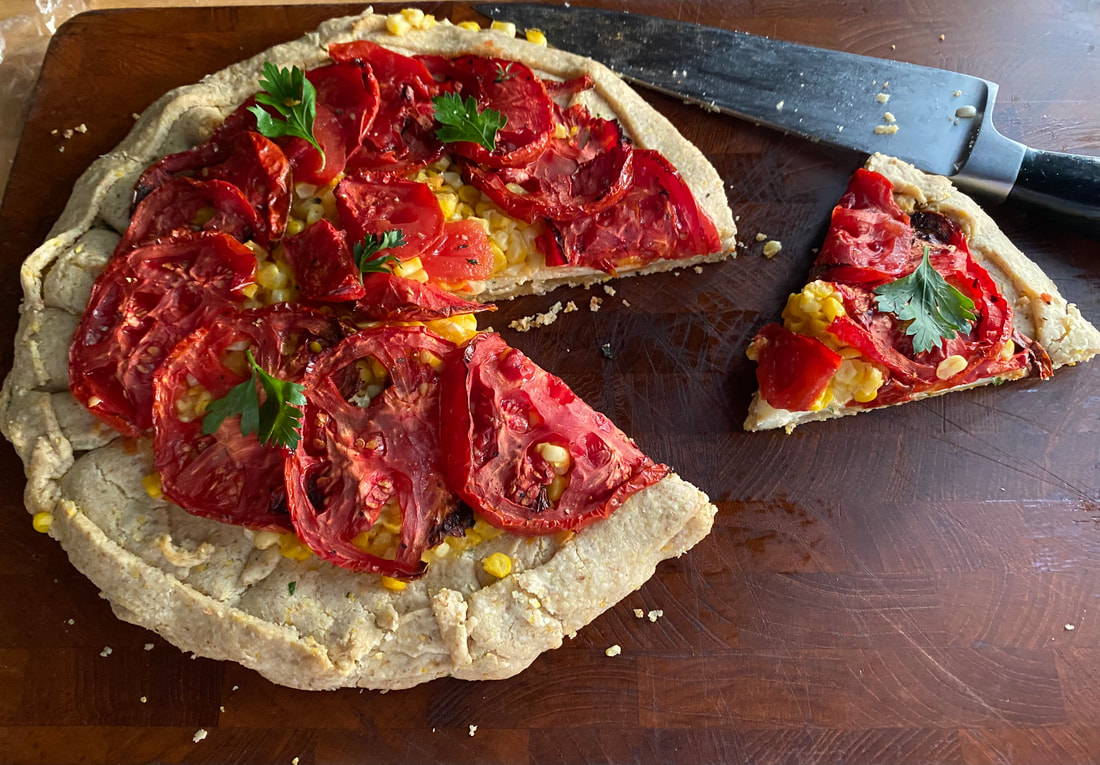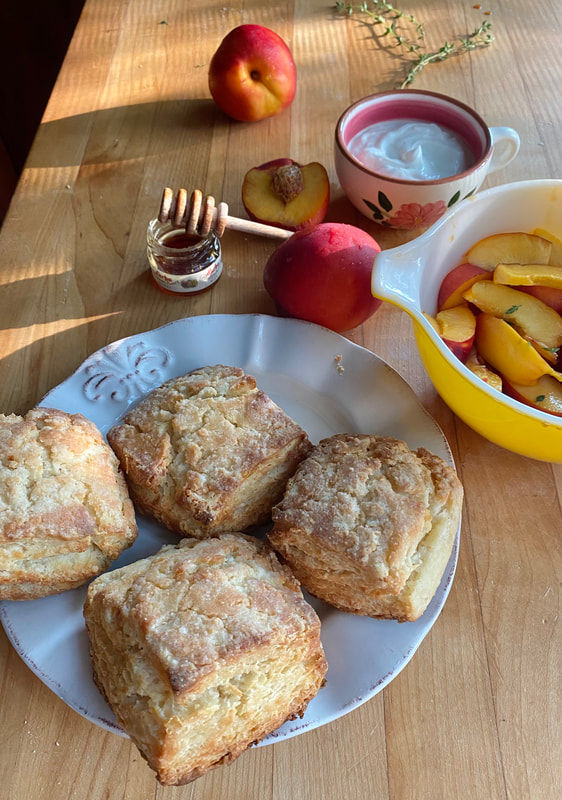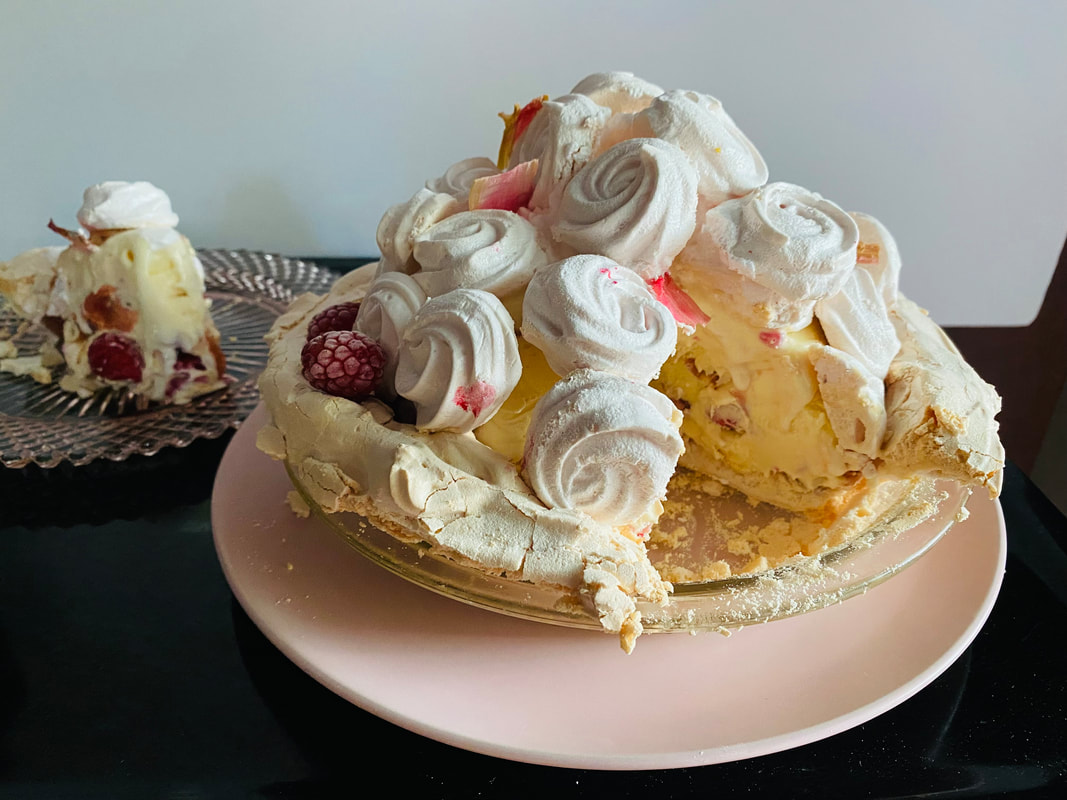|
In celebration of #nationalpecanpieday my preferred pie leans on brown butter, toasted pecans and golden syrup. Early pecan pies (prior to 1900), were in fact, custard pies studded with nuts. The sticky, dentist-friendly versions we associate with Thanksgiving were propelled by the invention of corn syrup (and the marketing genius from the folks at Karo). “Pacane” is a Native American word of Algonquin origin used to describe “a nut too hard to crack by hand.” Commercial pecan production is due in large part to the talents of an enslaved gardener, (history only refers to him by the name, Antoine), who successfully identified a means of propagating pecan trees in 1876, ultimately leading to propagation of pecans on a commercial level. Something to think about the next time you reach for a package of no fuss, ready-to-use shelled pecans.
While pecan pie tends to join the party in late fall (or when ponies are on the run), the right balance of toasty pecans against an all-butter crust and caramel-y filling deserves a place at the table regardless of the season. Take the time to toast the pecans and use a light hand with the sugar so you can appreciate the rich harmony of the ingredients. And the beauty of nut pie in summer (other than it’s scrumptious), is unlike certain stone fruits that may benefit from an extra day dozing on the counter, pecan pie can happen just like that.
0 Comments
When @flourambassador Amy Halloran was looking for a cookie recipe well suited to a discussion about rye flour and rye whiskey, a very specific cookie came to mind. Rye flour, once considered a little too hearty for baked goods, is enjoying a well-deserved Renaissance. Perfectly suited to the nibble-y, crunchy, dunk-able cookies that enjoy not one, but two spins through the oven, rye’s warm flavors complement rustic cookies. A thimbleful of rye whiskey makes a fine sipper alongside or in the manner of dipping biscotti in dessert wine, a fine dipper.
Twice-baked cookies are indelibly etched in my brain’s recipe Rolodex. These are the cookies we slice and bake and bake again. Long before coffee shops taunted us with cello wrapped biscotti boasting a-little-too-long shelf life (and a sure fire way to test the limits of dental work), twice baked cookies were mainstays in kitchens throughout the world. Layered between sheets of waxy paper in cookie tins both ornate and ordinary, my grandmothers appreciated the ‘good keepers’ that Mama Dorothy referred to as rusks while Mama Min called them mandelbrot. Without being overly sweet, the cookies were suitable regardless of the hour, enjoyed with and dipped in hot tea or strong coffee. Following recipes from Mrs. Simon Kander’s The Settlement Cookbook, Jennie Grossinger’s The Art of Jewish Cooking and Florence Kreisler Greenbaum’s The Jewish Cook Book, the cookies were also known as zwieback and toasted slices. Sometimes made with oil (in keeping with kosher dietary laws), other times with butter, the recipes were often flavored with anise, almond or cinnamon. It wasn’t unusual for Dorothy to enjoy candied fruit and ginger with the crunchy rusks, and Minnie to nibble on mandelbrot and Barricini chocolates during a spirited game of canasta. I found the cookies special not because of their taste, but because of the ceremony swirling around them. The tea and the coffee, the nibbling and the dunking. Long after my grandmothers had passed away, I was working at a restaurant that featured an intricate cookie assortment as one of the dessert offerings. Churning out innumerable logs of biscotti required a sensitive oven timer ear and an eagle eye. One learn's quickly that the fine line between golden and overdone is fleeting. Asbestos fingers were not an option but a requirement. The reward for this time consuming (and stressful) bake was enjoying the cut-off cookie ends, dunking them in lukewarm espresso. (Most bakers and pastry chefs will tell you that the coffee they consume throughout their shift is rarely, if ever, hot.) Dorothy and Minnie echo through my double-baked cookie recipe. One’s fondness for dried apricots and candied ginger add tartness and heat. The other’s affinity for cornmeal rye bread (plus her requisite candy dish filled with Jordan almonds) conjures warm memories. Which is often the short answer to why bakers bake. It was a soaker of a car ride on the way up to Albany last Friday, but I managed to arrive unscathed. Even squeezed in a brief visit with the multi-talented grain leader/writer/baker @flourambassador Amy Halloran.
Settled in the studio, we found room amidst the microphones for a trio of pies; sour cherry, maple/walnut/bourbon and Concord grape. Between forkfuls, host Ray Graf and I managed to field some calls and (hopefully) solve a few pie conundrums. For listeners curious about the mandate (it's more of a suggestion) of serving apple pie with cheddar cheese, in the state of Vermont there is in fact a 1999 law on the books requiring that apple pie proprietors make a "good faith effort" to serve the state pie with a glass of milk, a scoop of ice cream or a slice of cheddar weighing at least 1/2 ounce. The more you know, right? There are many weeks of apple pie opportunities ahead of us but currently, I'm focused on Concord grape pie. And happily, WAMC's Ray Graf is now a grape pie convert. Thanks for inviting me back to Food Friday, Ray. Whether you have a hankering for a loaf to enjoy nibble by nibble throughout the weekend, or are looking for an atypical break-the-fast apple cake, I've got you covered. But first, let's brush up on our Canadian food history. Namely, the importance of David Fife, a Scotch immigrant credited with planting Canada's first experimental farm.
Fife and his wife, Jane, were progressive farmers raising a family near Peterborough, Ontario. Searching for a strain of plants that were adaptable to Canada's harsh climate, Fife wrote to a friend in Scotland asking for seed varieties that would thrive. The Fifes dedicated a small section of their fields to growing the experimental crops sent from overseas. Their diligence led to the discovery of Red Fife, a hardy wheat that was adaptable to both fall and spring planting. Additionally, the grain was resistant to wheat rust, a serious threat to Canadian crops. From its tentative beginning on Fife's small farm, Red Fife made Ontario a wheat-producing province, paving the way for the Canadian grain farming industry. The heritage grain first planted in 1842 remained the dominant wheat grown in western Canada for 60 years. In the early 1900s, Marquis Wheat replaced Red Fife in popularity and production. Thanks to a small number of seed savers and organic heritage wheat farmers, (primarily in Canada), Red Fife is still a viable grain and is enjoying a resurgence today. The success of Red Fife wheat was a major factor in the settlement of the Canadian west and its farming industry. Historians and agriculturists claim that Red Fife wheat helped push back prairie grass allowing farmers to successfully work the land, ultimately sparking Canada's reputation as the "Granary of the Empire." Fife's diligent farming practices and his contributions to Canadian agriculture were recognized by the Senate in 1955. In 1963, the experimental farmer was inducted into the Canadian Agricultural Hall of Fame. During a recent visit to Picton, Ontario, I sought out Jubilee Farm Stand. Known for their hyper local produce, grains and maple syrup, their Heritage Red Fife Flour aligned perfectly with a recipe I've been itching to try from writer and chef Deborah Reid. (I made a few slight adjustments, primarily to incorporate honey and cider into the mix.) The auburn loaf is an enhanced applesauce cake, punctuated by a deeply toasty, almost cinnamon-y flavor from Red Fife flour. I've given the caramel glaze a serious hit of reduced apple cider and added some walnuts for crunch. This may very well be the dessert that elbows honey cake off the table until further notice. One of Rosh Hashanah’s sweetest traditions revolves around a loaf of bread. Customary for the Jewish New Year, a circular challah symbolizes many things, among them continuity. The conclusion of one year and the beginning of a new one provides a fresh canvas. I take the same approach with challah, a bread that is both showy and stubborn. Some bakers find challah making leisurely, spiritual, even restorative. It can be all of those things but primarily I see it as a study in and acknowledgement of imperfection. In pursuit of a cover girl challah lies the reality that a flawless loaf is in the eyes of the beholder.
At its best, the eggy dough is lush and pillowy, neither sticky nor dry. Well behaved challah dough rises dramatically without over proofing. It is agreeable to twists and turns without recoiling like a Slinky.and welcomes raisins or apples with the same ease as it does poppy or sesame seeds. Yet challah plays by its own set of rules reminding me each time that the dough will be ready when it's good and ready. This of course, results in a less meditative and therapeutic experience. I remind myself that challah is about the process, the crafting of the bread. Despite use of a kitchen scale with fresh batteries and a ruler with clear digits, I generally have to walk away during the process, allowing the ropes of dough (and the baker) to calm down. With each Rosh Hashanah, challah is the reminder of renewal, beginning with a thickly plaited, honey-sweetened (albeit imperfect) loaf. While braiding the four strands, (left moving to the right, over two and under one), I wondered if the little girls who excelled at braiding Barbie's ponytail grew up with a talent for braiding challah. Or do they opt for a store bought loaf? I'll choose to make my own, (slightly flawed) loaf every time because it reflects another chance to start fresh. From Leslie Mackie's Macrina Bakery
makes one ten-inch galette For the veggies 2 ears sweet corn, kernels removed and sautéed in 1-2 tablespoons butter until tender (or microwaved in their husks for 9 min. at medium/high power- careful they’ll be hot!, then kernels cut from cobs) 3-4 end of summer good size Jersey tomatoes For the cheese filling 2 eggs 14 oz. whole milk ricotta (can use low-fat but will be slightly runnier) 1 & 1/2 cups freshly grated cheese, preferably fontina 1/2 freshly grated Parmesan Reggiano 1/2 teaspoon chopped fresh parsley 1/2 teaspoon chopped fresh oregano (not dry) freshly ground black pepper to taste pinch kosher salt 1/2 teaspoon lemon zest Whisk together egg, cheeses, herbs and zest just ‘til combined. For the dough 1 cup all-purpose flour 1/4 cup finely ground cornmeal 1/4 cup rye flour 1/2 teaspoon kosher salt 1/4 teaspoon granulated sugar 4 ounces (1 stick) unsalted butter, cut into pieces 3-4 Tablespoons ice cold water In a large bowl, whisk together dry ingredients. Scatter butter pieces over dry ingredients. Cut butter into flour mixture using pastry blender or your fingers until butter is in pea-size pieces. Drizzle in cold water, a tablespoon at a time, just until you have a shaggy dough that just holds together. Pat into a disc. Wrap in plastic wrap and chill for an hour before rolling out. Wash and thickly slice tomatoes. Pat dry with paper towel. Place tomatoes in a single layer on parchment lined baking sheet. Drizzle with 1 tablespoon olive oil, salt and pepper to taste. Roast at 375 degrees for approx. 35-40 minutes until fragrant and edges are slightly caramelized. Set aside. Roll dough on a sheet of parchment into a circle approx. 14” about 1/8” thick. Spoon ricotta filling onto center of dough. Spread evenly leaving a 2” border. Fold border up over edge of filling, creating pleats. Brush edge with egg wash. Refrigerate for 30 minutes. Pre-heat oven to 375 degrees F. Bake galette on bottom rack of oven for 45-50 minutes, until crust is golden and filling is set. Let galette cool about 15 minutes before topping with corn, roasted tomato slices and a generous handful of fresh herbs. Can serve warm or at room temp. Cover and refrigerate any leftovers. Recently wrapped up peach season in Prince Edward County, Ontario which was pretty magical. Sun-kissed freestones are still available from local farm stands making those death-defying u-turns on county roads worth the risk. Seems locals are a touch more respectful of the fruit; there's less handling and grousing as they fill their baskets. Probably because many of the shoppers are farmers themselves.
Choosing your favorite peach adventure is easy; a generous 3 pounds will fill your favorite 9-inch pie plate. My leanings are always towards lattice. Soon enough orange gourds and neon honey crisps will steal the show. Peach, I miss you already. J. Robert Oppenheimer the physicist was also a mixologist. According to American Prometheus, the Pulitzer Prize-winning book and major source of info for the big screen blockbuster, Oppenheimer was known for hosting the occasional house party. His generous four-ounce pours of gin paired with a dash of vermouth were shaken, not stirred. Served icy cold, guests sipped from glasses rimmed with honey and lime juice. Of course, this little tidbit of Oppenheimer info got me thinking about pie.
From a dessert perspective, many of the components that work well in a cocktail shaker lend themselves easily to pie. Case in point, a frozen lime chiffon spiked with gin and a whipped cream finish sweetened with honey. A refreshing alternative to traditional key lime pie, I turned to a recipe from my Philadelphia Cafette days. Not a lick of sweetened condensed milk in the mix, no white chocolate, no cream cheese and thank goodness, no sheets of gelatin. Simply two eggs separated, yolks cooked over a double boiler with some sugar and fresh lime juice. Cooled down and combined with beaten egg whites, honey sweetened heavy cream and plenty of lime zest, the filling needs nothing more. Unless you have a penchant for cold gin and lime, which I do. The ever-so-slightly tipsy lime fluff fills a 9” pie plate or an 8” springform lined with a no-bake crust. Because there happened to be a package of chocolate filled wafer cookies within reach, I used those. (You could certainly use graham crackers or vanilla wafers or any such store-bought cookie.) Frozen for several hours, (or overnight if you are a patient sort), the pie tastes like what I imagine late August would taste like if it was a flavor. It’s light, tart and breezy and not terribly difficult to master. Quite unlike physics, which is certainly something I never, ever studied in school. One biscuit recipe is all you need and this is the one. A baby batch teamed with honey-drizzled nectarines and a hint of thyme is perfect for an August breakfast. If you have the patience, serve them for dessert.
@ericjoonho and @nytcooking have all the info you need to recreate the craggy edged, lofty buttermilk biscuits from Briana Holt's Tandem Coffee and Bakery in Portland, Maine. Buttermilk and sugar weave their magic in a recipe that comes together in a snap. Just play by Briana's rules and Eric's directive; let the grated butter lounge in the freezer for 10 minutes before mixing. They're so easy to make, I never think of them as anything but simple indulgence. Ad you can have them hot out of the oven dripping with butter long before you would ever tackle the lengthy drive to Maine. https://www.nytimes.com/2023/03/22/magazine/buttermilk-sugar-biscuits-recipe.html New Barbie is quite something. I had no idea how dramatically the fashion doll had changed until I sought one out at our local Target. Due to her upswing in popularity, pickings were slim. There was only one Barbie in the bunch who wasn't a mermaid, wasn't sporting rainbow Fantasy Hair and wasn't a pop star. The search for a no-nonsense Barbie was exhausting; so was trying to emancipate the doll from the hermetically sealed packaging. (It nearly cost me a finger.) In the end, New Barbie was an agreeable sort, stepping out of her denim shorts into yards of plastic wrap before being plunged into a bowl of vanilla ice cream swirled with rhubarb and raspberries. The doll stood perfectly still while I covered her in meringue rosettes, placed a candied rhubarb bow in her hair and snapped a photo.
It's been a while since I've handled a Barbie doll. I've forgotten how tiny everything is; the snaps on her clothing, the plastic shoes that mold to her feet, the rubber bands that secure her ponytail in place. Somewhere, buried in a box that moved from NY to NJ to Philly and back again to NJ, are remnants of my Barbie collection, including knitwear and crocheted garments handmade by my grandmother. As of this writing, I was only able to unearth one stray box of odds and ends from my Barbie past. Amongst the corduroy jumper and pink sparkle sweater were a few "antiques." The cardboard television/stereo console, bookcase, lamp and blue ottoman from Barbie's original 1960s dream house were still standing. According to a recent NY Times article, apparently Barbie owned the dream house single-handedly. Good for you, Barbie. It seemed only fitting that New Barbie should make herself comfortable in some vintage Barbie clothes, amidst some antique Barbie furniture. Should any future needs arise requiring Barbie to pop into a meringue filled pie plate, I'll know just where to find her. |
Archives
July 2024
Ellen GrayProfessional Pie-isms & Seasonal Sarcasm Categories |



















 RSS Feed
RSS Feed